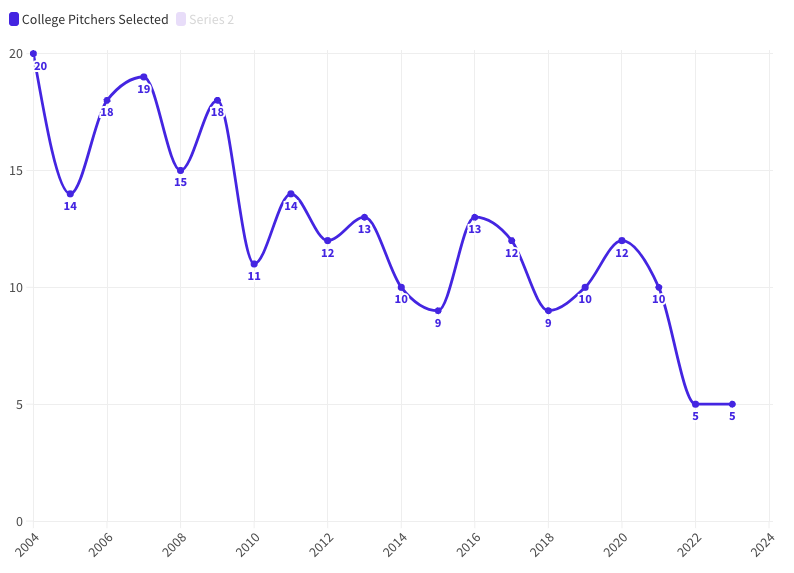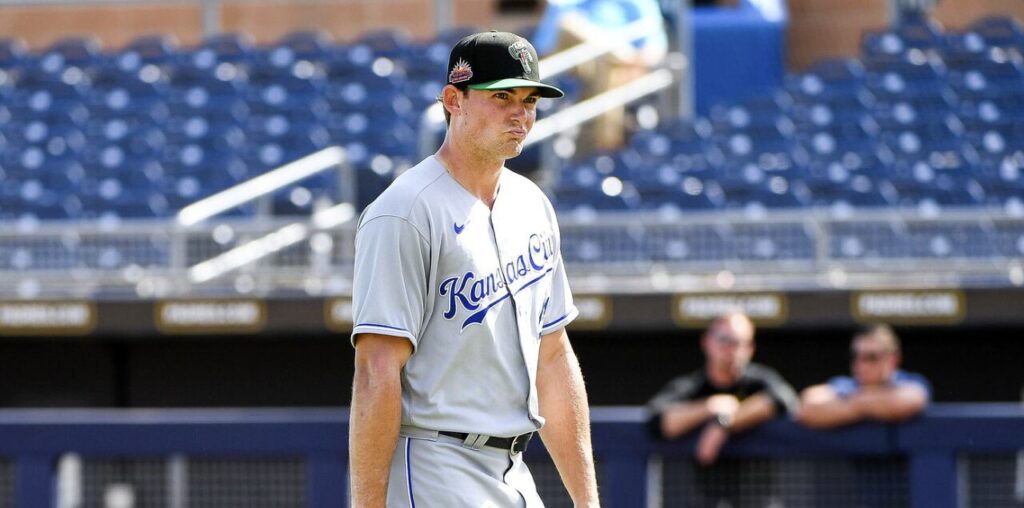What’s the bull case for drafting college pitchers as we conventionally know it? These are generally guys who have experienced success against more premium competition. They’ve proven more durable and have a tendency to advance through a minor league system more quickly. Long story short, there’s safety in college pitching.
You can go back almost 40 years and college pitching has been the most popular demographic in the majority of drafts. But over the last two decades less and less college pitchers are being selected in the first round. Furthermore, the hit rate on them of late hasn’t been terribly encouraging. 
There was a place in time when decorated college arms were the prize of any given draft. There was safety on the back of the baseball card. Teams hoping for a quick-moving middle-of-the-rotation starter are too often settling for an innings-eater that can be hidden in the bullpen. And in many cases less than that.
The year 2020 did a number on all of us. But it also threw the baseball industry, specifically scouting and player development, into a tailspin. How were MLB organizations supposed to scout players when high school and college games were cancelled all spring? Maybe worse, how were organizations expected to continue developing those already in their farm systems?
![]() Mock Draft 3.0 | Top 300 Prospects
Mock Draft 3.0 | Top 300 Prospects
Many expected the results to be dramatic, and so far that seems to be the case.
The 2020 draft was a whiff for so many organizations. The Cardinals stand out as clear winners in a draft that was foggier than any draft that came before it. The Orioles also seem to have walked away a winner with Heston Kjerstad and Jordan Westburg, though time will tell. For many teams at the top, the results haven’t been as fruitful. College pitching in particular has been rough.
Second-ranked @Marlins prospect Max Meyer (No. 21 overall) notches his first big league strikeout! pic.twitter.com/GKPN0rfVlw
— MLB Pipeline (@MLBPipeline) July 16, 2022
While Max Meyer‘s story is hardly written at this point, the Marlins No. 3 overall pick has amassed -0.1 fWAR in his young career having thrown just 11 inning in Major League Baseball. Much of his career has been spent on the shelf recovering from Tommy John.
Asa Lacy, the Royals No. 6 overall pick is yet to proceed past Double-A where command and control woes have derailed his progress. Emerson Hancock, the Seattle Mariners No. 6 overall pick, has steadily made his way up the developmental ladder, but shoulder injuries and an arsenal that hasn’t taken a jump have limited the former Georgia Bulldog to just 18.1 innings in MLB. He’s been worth 0.1 fWAR.
Reid Detmers has been the jewel of the class on the mound. The Angels No. 10 overall selection has 4.7 career fWAR in 303.1 career MLB-innings. It’s much of the same as you go down the line.
White Sox No. 11 selection Garrett Crochet has struggled to stay on the field. Arizona’s Bryce Jarvis has been a slow burn up the ladder. Nationals righty Cade Cavalli has been on the shelf injured for the better part of the last calendar year.
Jared Shuster was ineffective with the Braves and was shipped to the White Sox this past winter. The Pirates’ Carmen Mlodzinski and Arizona’s Slade Cecconi have both received cups of coffee with varying degrees of success.
Perhaps the saving grace of the 2020 draft in terms of college arms will be the Dodgers’ No. 29 overall pick Bobby Miller. A converted closer from the University of Louisville, Miller has been worth 3.2 fWAR in just 130.1 career innings at the big league level. He would seem to have impact potential in any rotation.
Bobby Miller‘s first MLB strikeout! #Dodgers pic.twitter.com/wnOgH0s6Jc
— Bruce Kuntz (@Bnicklaus7) May 24, 2023
Perhaps the bigger victim from the COVID-shortened 2020 season were pitchers who found themselves eligible in 2021. After all, they missed most of their sophomore campaigns on campus and could hardly train and develop during the shutdown.
Only ten college arms were selected in 2021 and the results have not been promising. The Rangers’ No. 2 overall pick Jack Leiter has struggled dramatically during his minor league career and has been the subject of a move to the bullpen if things continue. Angels’ No. 9 overall selection Sam Bachman has already taken on a role in the bullpen, though injuries have slowed his ability to gain any momentum in working to prove he can start.
Kumar Rocker was selected No. 10 overall by the Mets. He went unsigned but was since selected by the Rangers in 2022 and tore his UCL shortly thereafter. Michael McGreevy has effective, it not uninspiring for the Cardinals after being selected No. 18 overall. His 7.2 career K/9 mark is one of the lowest in recent memory for any first round college pitcher selected in the first round. He’ll start 2024 at Triple-A.
Blue Jays’ No. 19 selected Gunnar Hoglund and quickly flipped him to Oakland where he’s struggled to miss bats to the tune of a career 5.45 ERA. He’s yet to see Triple-A. The Braves selected Ryan Cusick out of Wake Forest and quickly traded him to Oakland where he’s struggled.
The jury is still out on Cubs’ first rounder Jordan Wicks and Cleveland’s first rounder Gavin Williams. Both have flashed big-league capable stuff, though neither has captured a spot at the highest level yet. Both will turn 25 years old during the season.
✅ First MLB strike out#ForTheLand pic.twitter.com/z33Cag3th1
— Bally Sports Cleveland (@BallySportsCLE) June 21, 2023
It’s important to note those selected in the 2021 Draft have really only been pitching in full season affiliated ball for two full seasons. They’re still reasonably young. But the majority of them have yet to show signs of true impact or turning a proverbial corner.
College pitching really slammed on the brakes in 2022 when only five hurlers heard their names called in the first round — the fewest selected in the first round since 1982 — 40 years. The jury is still out on these guys, though early results haven’t taken the league by storm.
The Rockies’ No. 10 overall selection Gabriel Hughes has hardly pitched recovering from Tommy John. The Cardinals No. 22 selection Cooper Hjerpe enters 2024 with just 8 starts under his belt after requiring elbow surgery to remove bone chips. Guardians’ draft pick Justin Campbell hasn’t thrown a professional pitch yet, and DBacks first rounder Landon Sims has been working his way back from his own elbow surgery showing rust late in the 2023 season.
The Pirates selected Tom Harrington with the No 36 overall pick and he’s been solid, though he’s yet to get a taste of Double-A.
It was much of the same in 2023, though the class looks a bit more stout than the crops from years past. Paul Skenes went No. 1 overall to the Pirates and all signs point toward a much anticipated debut early in the spring. Rhett Lowder and Chase Dollander have yet to throw a professional pitch, though their amateur resumes are quite impressive.
Hurston Waldrep went to the Braves at pick No. 24 and dominated in his pro debut, though he carries a significant amount of relief risk. And LSU righty Ty Floyd went No. 38 to the Reds and scouts are eager to see him in 2024.
The rate college pitchers are being selected in the first round of the draft is most certainly falling. At time of publish, FSS Plus has nine college pitchers inside its top 35 prospects for the 2024 Draft. Maybe this is a more fruitful summer for that demographic. But trends haven’t been kind and professional baseball is in dire need of someone to break the mold.
- The Diamondbacks return for Josh Naylor… - July 25, 2025
- Five 2025 draft picks that could win Rookie of the Year in 2026 - July 21, 2025
- 2025 MLB Draft: The predictions you didn’t know you needed - July 16, 2025















